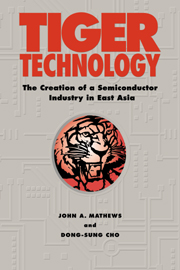Book contents
- Frontmatter
- Contents
- List of Figures
- List of Tables
- Preface
- Abbreviations
- Introduction
- Part I The ‘Real’ East Asian Miracle
- 1 Tiger Chips: The Rise of East Asia in the Global Semiconductor Industry
- 2 Technology Leverage as Latecomer Strategy
- Part II National Institutional Pathways
- Part III The Technology Leverage Strategy
- Appendix I Exchange Rates: 1975–97
- Appendix II Chronolog
- Glossary
- Bibliography
- Index
1 - Tiger Chips: The Rise of East Asia in the Global Semiconductor Industry
Published online by Cambridge University Press: 09 October 2009
- Frontmatter
- Contents
- List of Figures
- List of Tables
- Preface
- Abbreviations
- Introduction
- Part I The ‘Real’ East Asian Miracle
- 1 Tiger Chips: The Rise of East Asia in the Global Semiconductor Industry
- 2 Technology Leverage as Latecomer Strategy
- Part II National Institutional Pathways
- Part III The Technology Leverage Strategy
- Appendix I Exchange Rates: 1975–97
- Appendix II Chronolog
- Glossary
- Bibliography
- Index
Summary
Rarely has a technological device so dominated an era. The transistor, only invented in 1947, and then the silicon chip, now feed into a vast array of products and processes, investing them with powers of intelligence that were unthinkable just a few years ago. These tiny slivers of silicon, etched with layers of metal and polymers to spin high-technology webs of unbelievably complex circuitry are the critical technological drivers of our time, creating new products like digital watches, personal computers, high-definition television – and new industries to manufacture them.
Integrated circuits (ICs) have grown in complexity so that what started as a single device – the transistor – now encompasses millions of devices embedded in a single piece of silicon. These are the ‘megabit’ chips like dynamic random access memories (DRAMs) which, by the year 2000, are reaching the one-gigabyte level: one chip with a thousand million devices embedded in it. This complexity feeds into a multitude of new uses, blending sound, image, text and data in cunning worldwide webs of multimedia information generation and exchange. New worlds of fantasy are spun out of them, a new world of virtual reality.
The world of business that generates wealth from these chips is anything but a ‘virtual’ reality. The wealth generated on the US West Coast in Silicon Valley, where the chips were designed and, to some extent, fabricated, and Hollywood, where the chips are used to conjure dreams, is all too real.
- Type
- Chapter
- Information
- Tiger TechnologyThe Creation of a Semiconductor Industry in East Asia, pp. 29 - 70Publisher: Cambridge University PressPrint publication year: 2000



